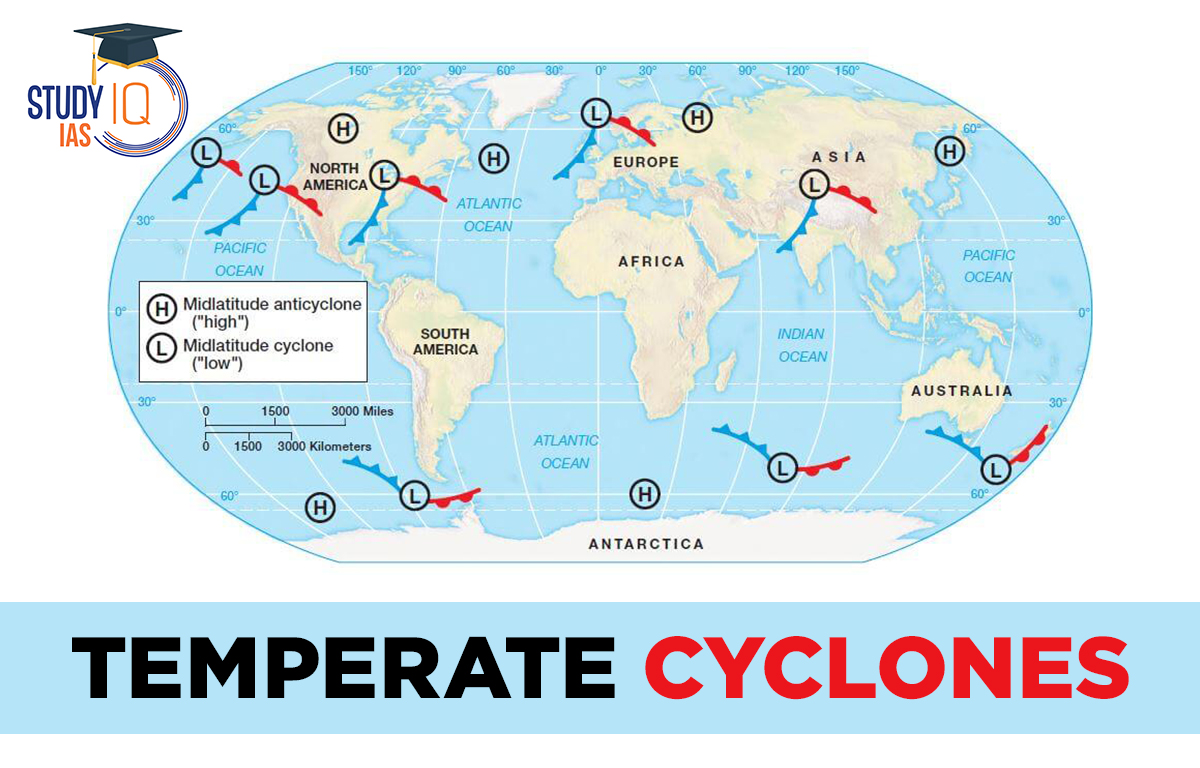Table of Contents
Temperate Cyclones
A temperate cyclone is a type of storm that forms in the mid-latitudes. It is similar to a tropical cyclone but has some differences. These storms usually develop between October and April, starting in places like the Gulf of Alaska or off Japan, and they can also form in the Southern Hemisphere. Temperate cyclones create low-pressure areas and are most common between 30° and 60° latitude. They can happen any time of year but are more frequent in fall and winter. These cyclones are also called extra-tropical cyclones because they form outside the tropics. This information is important for IAS candidates and will be helpful for UPSC aspirants.
Read More: Anticyclones
Cyclones
Cyclones are local low-pressure systems with converging air from surrounding areas. The Coriolis Force deflects the cyclone and provides a whirling motion. In the Northern Hemisphere, cyclones spin counter-clockwise, while in the Southern Hemisphere, they spin clockwise. The isobars, which are lines connecting areas of similar pressure, are closely looped and often look like circles or ellipses. Cyclones are generally divided into two main types:
- Temperate Cyclones
- Tropical Cyclones
Temperate Cyclones Phenomena
The temperate cyclone is one of the most important atmospheric phenomena affecting weather in the middle latitudes. They are also known as extra-tropical cyclones (beyond tropics) or mid-latitude cyclones or frontal cyclones. They are low-pressure systems with associated cold fronts, warm fronts and occluded fronts. They are an integral part of the global air circulation involved in heat transfer thus maintaining the Heat Budget of Earth.
Also Read: Cyclone Biparjoy
Temperate Cyclones Formation
The formation of the temperate cyclone is explained by the Polar Front theory by Bjerkens and Bjerkens, which was propounded during World War 1.
Stage I Frontogenesis
Two air masses converge along the sub-polar low-pressure belt in the northern hemisphere. The cold air mass moves southward and the warm air mass moves northward and forms a boundary where the winds blow parallel but in opposite directions.
Stage II Cyclogenesis
The different air masses start to push into each other’s areas. The warm air moves into the space held by the cold air, and the cold air moves into the warm air. This is how wave formation begins, setting up a strong cyclonic circulation.
Stage III Mature Stage
After the circulation starts, the storm begins to form waves. The warm air moves further into the cold air’s area, and the cold air moves toward the equator along the cold front. This is known as the mature stage of the cyclone.
Stage IV Occlusion Stage
The cold front moves in faster than the warm front and pushes into the warm area. This makes the warm area smaller, and the cold front eventually overtakes the warm front. The two air masses mix together at the front, and the occluded front disappears. In the end, the cyclone fades away.
Temperate Cyclones Characteristics
- Extra-tropical cyclones are storm systems that form in mid-to-high latitudes, away from the tropics.
- They are low-pressure systems with warm and cold fronts that develop near the polar front.
- At first, the front stays still.
- In the Northern Hemisphere, warm air comes from the south and cold air from the north.
- When the pressure drops along the front, it starts to spin counter-clockwise, moving warm air north and cold air south.
- This creates a strong cyclone with both a cold front and a warm front.
- As warm air rises over cold air, clouds form and it begins to rain.
- The cold front pushes in, forcing the warm air higher and creating cumulus clouds.
- The cold front moves faster, takes over the warm front, and lifts all the warm air, causing the cyclone to fade.
- These cyclones can form over land or water and can cover large areas.
Temperate Cyclone Movement
Temperate cyclones are usually less organized than tropical cyclones. They move from west to east across continents. In the Northern Hemisphere, they spin counter-clockwise around a low-pressure center, while in the Southern Hemisphere, they spin clockwise. While these cyclones can form at any time of the year, they are most common between September and May.
Temperate Cyclone Associated Weather
- Temperate cyclones spin counterclockwise and can cause heavy rain, thunderstorms, wind gusts, and sometimes hail. They can also produce tornadoes.
- The strong winds from these cyclones can damage buildings, trees, and power lines, and create large waves along coastlines, leading to flooding and beach erosion.
- These cyclones can bring strong winds, heavy rain or snow, and thunderstorms, with occasional tornadoes.
- One of the most destructive temperate cyclones was Sandy, which struck the northeastern U.S. in 2012.
- Despite their name, temperate cyclones can happen in both tropical and temperate areas.
Differences between Temperate Cyclone & Tropical Cyclone
| Tropical Cyclone | Temperate Cyclone |
| Tropical cyclones go westward from eastward. | These cyclones travel eastward from westward. |
| Comparatively speaking, a tropical storm affects a lesser region than a temperate cyclone. | A substantially wider area is affected by temperate cyclones. |
| In a tropical cyclone, the wind is blowing faster and more destructively. | Air moves at a relatively slower speed. |
| Only in waters that are warmer than 26–27 degrees Celsius do tropical cyclones form, and they vanish once they land. | Both on land and in the ocean, temperate cyclones can develop. |
| One tropical cyclone lasts no longer than seven days. | A temperate cyclone can persist for between 15 and 20 days. |
Tropical Cyclone UPSC
When two opposing air masses, such as thin polar air masses and heavy tropical air masses, clash, temperate cyclones are created. Extra-tropical cyclones are another name for temperate cyclones. Extra-tropical describes cyclones that form in a latitude range of 30° to 60° and take place outside of the tropics. You will learn about Temperate Cyclones in this article, which will help you with your preparation for the UPSC Civil Service Exam in geography.


 Story of Meera Bai and Her Devotion For ...
Story of Meera Bai and Her Devotion For ...
 Desert Climate, Distribution, Climatic C...
Desert Climate, Distribution, Climatic C...
 Deserts of India Map, Features of Thar D...
Deserts of India Map, Features of Thar D...





















